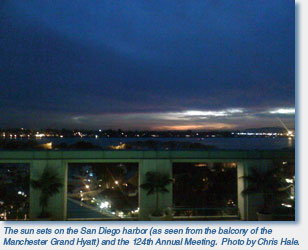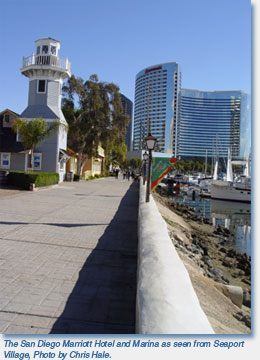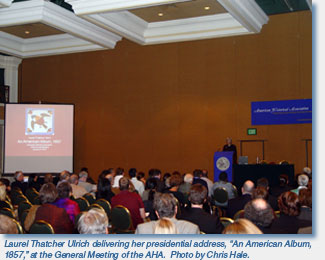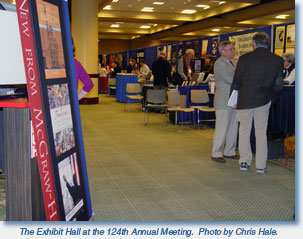 The 124th Annual Meeting of the AHA, held January 7–10, 2010, in San Diego, California, turned out to be as lively, exciting, and intellectually stimulating as any of the Association’s meetings in the recent past. Difficult as it is to summarize the myriad ways in which the annual meeting serves historians who attend, we present below some vignettes to give an impressionistic look at the four-day meeting.
The 124th Annual Meeting of the AHA, held January 7–10, 2010, in San Diego, California, turned out to be as lively, exciting, and intellectually stimulating as any of the Association’s meetings in the recent past. Difficult as it is to summarize the myriad ways in which the annual meeting serves historians who attend, we present below some vignettes to give an impressionistic look at the four-day meeting.
Given the economic difficulties—individual as well as institutional—and the west coast location, the number of people who registered for the meeting (just over 4,100) was, disappointing though it might have been, was not inordinately so. Clouds of anxiety had hung over the headquarters office during the months of preparation leading up to the meeting because of the controversy over a proposed boycott of one of the meeting hotels, the Manchester Grand Hyatt (for a brief discussion of this boycott move and the AHA’s response, see Vice President Karen Halttunen’s article in the October 2009 issue of Perspectives on History). But these clouds were quickly dispelled once the meeting got off to a splendid start on Thursday afternoon, not so much by the balmy weather and sunny skies of San Diego, as by the promise of a vibrant and busy program, made particularly enlivening for this meeting by the many special sessions (focusing on same-sex marriage) that had been organized partly in response to the boycott proposals.
These special sessions, which constituted a miniconference threaded throughout the meeting and also included a special plenary session, illuminatingly served to underline the connections between the past and the present by bringing the historical perspective into discussions of a contemporary issue of immediate concern to historians and the general public alike (the special sessions were, in fact, open to anyone who wished to attend). Several other sessions also showed the linkages between the past and the present, whether it was the sessions devoted to analyses of the current presidential administration or the future of the printed book.
 The annual meeting wasn’t entirely given over to discussions of the new-fangled and the contemporary. The traditional examinations of historical events and processes were in full force too, such as the sessions devoted to the French Revolution and to the British Empire. Then there were many sessions focusing on the annual meeting’s theme, “Oceans, Islands, Continents.” Not surprisingly, the plenary session on Thursday evening, with which the 124th annual meeting was formally opened (although sessions had been held since 3 p.m. that day), “Musical Encounters in the Early Atlantic: An Exploratory Performance,” was itself connected to the meeting theme.
The annual meeting wasn’t entirely given over to discussions of the new-fangled and the contemporary. The traditional examinations of historical events and processes were in full force too, such as the sessions devoted to the French Revolution and to the British Empire. Then there were many sessions focusing on the annual meeting’s theme, “Oceans, Islands, Continents.” Not surprisingly, the plenary session on Thursday evening, with which the 124th annual meeting was formally opened (although sessions had been held since 3 p.m. that day), “Musical Encounters in the Early Atlantic: An Exploratory Performance,” was itself connected to the meeting theme.
The theme ran through another increasingly popular feature of the meeting, the film festival, which drew even greater interest this year (for details, see the article by Chris Hale).
AHR Open Forum
At a lunch-time open forum held on Friday, January 8, 2010, Robert A. Schneider, the editor of the American Historical Review, Associate Editor Konstantin Dierks, and a team of editorial assistants revealed the intricacies of processing articles and book reviews for eventual publication in the historical journal.
Nearly 300 articles arrive each year at the AHR’s office in Bloomington, Indiana, the editors said. To decide whether a submission is acceptable, the editors look, not only for excellent scholarship and originality, but also, most importantly, for content that speaks across the profession, transcending subdisciplinary boundaries. If an article is accepted as appropriate for the pages of the AHR, the editor forwards the draft to members of the editorial board along with his own comments.
If the editors decide to proceed further with the article, it is sent to two experts in the field but without identifying the author. These “external” experts provide extended and elaborate comments and suggestions for revisions. By this time, the manuscript has thus accumulated six extremely useful critiques, and an author benefits from these even if an article is not ultimately accepted, declared Schneider.
The 2010 General Meeting
 The AHA’s General Meeting was held on Friday, January 8, 2010. After the presentation of awards to recipients of AHA honors and prizes (see the complete list of the various recipients and the related citations), AHA President Laurel Thatcher Ulrich gave her presidential address entitled “An American Album.”
The AHA’s General Meeting was held on Friday, January 8, 2010. After the presentation of awards to recipients of AHA honors and prizes (see the complete list of the various recipients and the related citations), AHA President Laurel Thatcher Ulrich gave her presidential address entitled “An American Album.”
She found it useful sometimes to address large questions by focusing on a single object, said Ulrich, delivering her presidential address The object in question was a simple quilt, made in the Utah territory in 1857. But she unfolded it to lucidly tell a complex historical tale of patriarchal politics, ideologies, and religious beliefs. Originally made in the same epochal year as the Dred Scott decision and the mutiny in India, the quilt was sundered into two when it was passed on 60 odd years later as a legacy to the next generation. Only after another hundred years had passed by was it made whole again by a descendant who not only joined the two halves, but also gathered details about the women who had contributed to the making of the quilt. Work of such amateur historians and genealogists was valuable and should be acknowledged, said Ulrich, who then went on to stitch those details into her own reading of the quilt. Taking a close look at some of the quilt’s many and variegated squares, Ulrich delighted the audience with insightful and perceptive revisionings of what the quiltmakers inscribed into the fabric, situating the new, seemingly simple, but elaborate narratives into histories of interpersonal relations, of the Mormon Church, and of public reactions to polygamy and the politics of gender. The address, which has been published in the February 2010 issue of the American Historical Review, was another captivating example of Laurel Ulrich’s remarkable ability of taking a simple object and transforming it into an artifact of compelling historical interest and narrative power.
The CWH Breakfast
Speaking on Saturday morning, January 9, 2010, to a large gathering at the breakfast meeting of the Committee on Women Historians, John D’Emilio (Univ. of Illinois at Chicago) declared that waging battles in courts to secure the right to have same-sex marriages is an entirely incorrect strategy for the gay and lesbian community.
Although he was an activist himself, he has been troubled for a long time, D’Emilio said, by the attempts to secure same-sex marriage rights in the courts. Tracing the history of seemingly successful legal cases, D’Emilio said that that the narratives of success conveyed only a part of the story, as the reaction to these court victories had, in fact, evoked widespread and deleterious consequences, in the form of amendments to state constitutions or other legislative measures that emphatically restated that marriage could only be between a man and a woman.
Pointing out that the institution of marriage was already undergoing radical transformations (single parents, simplified divorces, and so forth) despite the concerted efforts of the religious right, what was needed, perhaps, D’Emilio said, were campaigns that built alliances with groups that were advocating and advancing more liberal interpretations of marriage and thus move with the streams of history.
D’Emilio went on to say that there was a moral problem as well—that any benefits that may be secured by reaching the goal of the right for same-sex marriage would accrue disproportionately to a tiny social segment. Some people wrongly thought, D’Emilio said, that securing equal rights in marriage was a noble and ultimate aim, when there were other more important social goals to pursue and achieve (such as universal health care), and which, in fact, might actually render striving for same-sex marriage rights unnecessary altogether.
Concluding in a lighter vein, D’Emilio who was arguing against litigation for same-sex marriages, declared he was all for weddings, for weddings celebrated love, love that not only joined the couple but their worlds.
During the lively discussion that followed D’Emilio’s presentation, one member of the audience contended that the argument that D’Emilio advanced (that courts cannot legislate social change) was clearly negated by both Roe v. Wade and Brown v. Board of Education. In response, D’Emilio declared that those two Supreme Court decisions were really the culminations of a series of legal precedents set over many years and were reflections of evolving social and cultural attitudes, whereas the lower court decisions on same-sex marriage were more ad hoc and specific to particular cases.
D’Emilio agreed, however, with another argument advanced from the floor, that all the court cases and the consequent controversies may have contributed to an increasing awareness about the issues involved, and even helped to create a more tolerant atmosphere among younger people.
 The Job Center
The Job Center
The economic downturn and institutions reserving their own space for interviews made the Job Center a quieter affair at the 2010 annual meeting in San Diego. The Job Center’s staff were informed of 115 total searches active at the annual meeting, down from 198 in New York in 2009 and 260 in Washington, D.C. in 2008. Thirty-one of the searches in San Diego were collecting c.v.’s on site, down from 44 in 2009 and 62 in 2008, though the ratio of open searches to total searches remained roughly the same (27 percent this year versus 22 and 24 percent in previous years, respectively). The average Job Center search conducted 11 interviews over the course of the weekend, a number remarkably unchanged from previous years.
Historically, about a third of the searches at the Job Center are in U.S. history. That remained unchanged in 2010 (31 percent). European history dropped to 18 percent of searches (from 21 percent in 2009), while Asian history represented 14 percent of searches, thematic history 14 percent (the biggest gainer, up from 6 percent in 2009), world history 8 percent (down from 12 percent in 2009), Latin American history 8 percent, African history 5 percent, and Middle Eastern history 3 percent.
The Exhibit Hall
The meeting registration area (less crowded this year because of the smaller number of attendees) was located right beside the exhibit hall this year making it easy to pick up the meeting badge and set out immediately on the hunt for books, acquisitions editors, publishers, or friends and colleagues. With 75 exhibiting companies, it did not take long to find something of interest. The familiar faces were there to welcome attendees to the booths of regulars such as Bedford/St. Martin’s, Random House and Oxford University Press. First time exhibitors included Baylor University Press, National Social Science Press, Research Institute for Hawaii USA, U. S. Department of State, Office of the Historian and La Universidad Nacional Autónoma de México Instituto de Investigaciones Históricas. The exhibit hall remained one of the more popular parts of the annual meeting with steady traffic throughout.
Composed by Pillarisetti Sudhir with contributions from David Darlington, Kelly Elmore, and Elisabeth Grant. Some sections of this article were published earlier on the AHA blog, AHA Today.
Tags: Annual Meeting Annual Meeting through 2010
Comment
Please read our commenting and letters policy before submitting.






